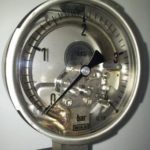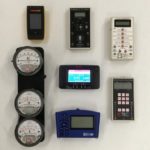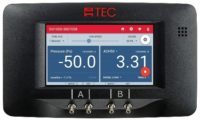The Evolution of the Digital Pressure Gauge
Evolution of the Digital Pressure Gauge
(Originally printed in The NEBB Professional: http://www.nebb.org/assets/1/7/NEBB_Magazine_Quarter4_2016_E_Web.pdf)
by Frank Spevak
Evolution of the digital pressure gauge: From mercury and liquid to crystals and computers, pressure gauges have evolved dramatically since the 1600s. Five scientists set the foundation for technology in today’s gauges with their discoveries over a 200-year period. Today HVAC contractors are equipped with knowledge and tools to measure pressure and offer data-driven recommendations that help clients make energy efficient decisions for their buildings.
In high school science class we learned about the discoveries, observations, theorems, and laws that led us to a modern understanding of pressure. But for many of us, that was quite a while ago.
Pressure constantly surrounds us and resides within us in various forms. In the mid-17th century, physicists started to explore what pressure is, how it disperses, and how we can measure it. We can thank five famous scientists for our modern understanding of pressure: Evangelista Torricelli, Blaise Pascal, Christiaan Huygens, Daniel Bernoulli, and Henri Pitot.
These great minds used early experiments related to transporting water to set the foundation for the modern electronic instruments that are now commonplace. Many test and balance firms and HVAC contractors rely on the results from these experiments every day they are on the job.
Origins of Pressure
Evangelista Torricelli
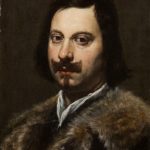 The first of our five famous scientists is Evangelista Torricelli, an Italian physicist and mathematician. Torricelli is credited with the development of the first barometer in 1644. The name derives from two other words – baro for weight and meter for measure.
The first of our five famous scientists is Evangelista Torricelli, an Italian physicist and mathematician. Torricelli is credited with the development of the first barometer in 1644. The name derives from two other words – baro for weight and meter for measure.
The barometer is an inverted tube of mercury under vacuum, placed in a base pool or reservoir of mercury. As atmospheric pressure is exerted on the reservoir of mercury, the column of mercury in the tube rises and falls. By placing marks on the column, the “weight” of air could be measured for the first time in history. Torricelli’s barometer is known as an “unvented single liquid column manometer.”
Blaise Pascal
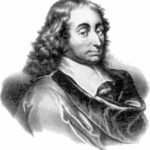 The second of our famous scientists is Blaise Pascal, a French mathematician and physicist. Pascal’s great discovery was that pressure is evenly displaced within a vessel. This means when pressure is introduced inside a containing device, like a jar, pressure measurements on one side of the jar are equal to pressure measurements on the other side of the jar.
The second of our famous scientists is Blaise Pascal, a French mathematician and physicist. Pascal’s great discovery was that pressure is evenly displaced within a vessel. This means when pressure is introduced inside a containing device, like a jar, pressure measurements on one side of the jar are equal to pressure measurements on the other side of the jar.
To translate this concept for today, if we add air into a house or building with a fan, then the pressure on the west side of the building will be the same as pressure on the east side. For the moment, we’ll put aside other atmospheric conditions such as wind.
Both Pascal and Torricelli are so important in the world of pressure measurement that units of measure have been named after them. The Torr is named after Torricelli and the pascal (Pa) after Pascal.
Fluid Mechanics
Christiaan Huygens
 Our next discoverer is Christiaan Huygens, a Dutch mathematician and scientist. Huygens is credited with the invention of the liquid column or u-tube manometer, not related to the internet service for watching videos. The u-tube manometer differs from the barometer in that the u-tube can be vented to atmosphere or connected to another source of pressure. When there is no pressure difference from one side of the column to the other then the value is zero. Once pressure is applied to one side, then the liquid is forced down one side and up the other making it possible to measure force.
Our next discoverer is Christiaan Huygens, a Dutch mathematician and scientist. Huygens is credited with the invention of the liquid column or u-tube manometer, not related to the internet service for watching videos. The u-tube manometer differs from the barometer in that the u-tube can be vented to atmosphere or connected to another source of pressure. When there is no pressure difference from one side of the column to the other then the value is zero. Once pressure is applied to one side, then the liquid is forced down one side and up the other making it possible to measure force.
Daniel Bernoulli
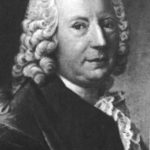 The next person on our list of famous inventors is Daniel Bernoulli, a Swiss mathematician and physicist. Bernoulli came from a family of scientists with an impressive 10 relatives contributing to our understanding of various aspects of science.
The next person on our list of famous inventors is Daniel Bernoulli, a Swiss mathematician and physicist. Bernoulli came from a family of scientists with an impressive 10 relatives contributing to our understanding of various aspects of science.
Bernoulli was mostly concerned with fluid mechanics. The main theory he created that we use today is that an increase in the speed of a fluid occurs simultaneously with a decrease in pressure. Bernoulli’s theory explains many everyday occurrences such as how airplanes fly and why curveballs happen in baseball. When it comes to measuring air flow in ductwork, Bernoulli is sitting with each HVAC technician that uses a Pitot tube, an invention named after our fifth scientist.
Henri Pitot
Henri Pitot, a French hydraulic engineer, is credited with the invention of a tube that mixes the theory of Bernoulli with the invention of Huygens. Instead of an unvented u-tube, the sides of Pitot tubes are connected to pressure ports that point into the direction of air flow and perpendicular to the air flow. With Pitot’s invention, we are able to measure the Bernoulli theory because when pressure on the side increases, the flow moving along the duct decreases.
Mechanical Instruments
A number of advances in measuring pressure occurred in the decades and centuries after these scientists made their discoveries:
- Bourdon tube: A sealed, curved tube that straightens as pressure inside the tube increases. A needle movement is attached to provide a measurement.
- Bellows and diaphragm gauges: Bellows-type gauges use the expansion or contraction of a folded membrane to determine pressures while a diaphragm gauge uses the expansion or deflection of a membrane to determine pressure. These gauges measure the mechanical action as pressure is applied.
- Magnehelic® gauge: A helical gear is attached to a diaphragm to move a needle.
Liquid and mechanical gauges have served a variety of industries in a very wide range of applications. These devices were scaled up and down for various pressure values suited to the respective industries. These types of gauges have their limitations, however, because it is difficult to attach an electrical lead to a liquid or mechanical gauge.
This left us with gaps in our knowledge, such as how do measurements get transmitted elsewhere in an office or factory, and how can we record and store information from a liquid device?
The answers came when inventors figured out how to measure an unknown electrical resistance.
Electrical Resistance to the Rescue
In a completely unrelated field in the early 1800s, inventors were working to solve a different mystery of measurement. The question was how to measure the resistance of an unknown electrical component. The answer was to use three known legs of an electrical circuit to measure the unknown fourth leg. This concept was developed by Samuel Christie in 1833 and was later improved upon by Sir Charles Wheatstone in 1843. The circuit became known as the Wheatstone Bridge and is in a staggering number of electronics used every day. In particular, it can be found in a large number of measurement devices, such as resistance thermometers, hot wire anemometers, and strain gauges.
Strain gauges have the ability to electronically measure force, making them of great interest to us today. By laying out the Wheatstone Bridge on a surface, then applying force to that surface, there is a change in resistance. The change in resistance is then calibrated against other means of measuring force. The result is a calibrated electrical circuit that measures pressure.
Pyroelectric and Piezoelectric Effects
In the mid-1800s, one group of scientists determined that temperature can affect electrical generating properties of materials, while another group experimented with the relationship between electrical charge and mechanical stress. The Curie brothers advanced these experiments with their knowledge of pyroelectric effect of the underlying structure of crystals. The brothers were ahead of their time. These experiments remained in the laboratory as an answer to a question that was not yet asked.
The 200-year period from the mid-1600s to the mid-1800s created wonderful scientific achievements, but the world had to come up with even more inventions and electronics to bring us to today.
Electronic and Digital Devices
In 1906, one of the first practical uses of a piezoelectric device was sonar to detect icebergs. Crystals were layered between two pieces of steel with the Wheatstone Bridge conducting electricity. This combination of steel, crystals, and electrical components detected a returning sound pressure wave. Once this technology proved successful, development and adaptation occurred swiftly. Of course, the advent of computers and various processor technology didn’t hurt either.
The ability to develop small, consistent crystals with embedded electrical circuits triggered the digital pressure gauge industry, eventually leading to the advanced microprocessors of today. Modern digital pressure gauges behave similarly to handheld computers rather than devices used solely to measure pressure.
Today’s gauges have the ability to connect to the internet wirelessly, perform automated tests and export large amounts of data for thorough analysis. They equip contractors with the power to offer clients data-driven recommendations that help conserve energy in buildings.
Inventions have advanced exponentially in past centuries, but the industry’s technology is far from complete. Manufacturers push the envelope of what’s possible every day, equipping contractors with the most advanced, accurate, and reliable digital pressure gauges.

